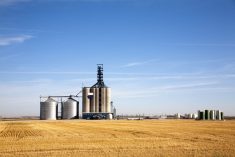GACKLE, N.D., July 25 (Reuters) – Yield prospects for hard red spring wheat in southeastern North Dakota were below average following hot and dry weather during the growing season, scouts on an annual crop tour said Tuesday.
But the Wheat Quality Council tour’s early yield calculations were not as bad as some had feared.
“So far, I would say this is better than what most folks expected,” said Kevin Ernst, a broker with Chiodo Commodities who is on the tour.
Tour participants today were in eastern parts of the state that have had better moisture than in the western parts where there is severe drought.
Read Also

Canadian crop outlook has improved since January says FCC
Canadian farmers’ overall new crop outlook has improved since the beginning of the year, says Farm Credit Canada.
Scouts on one leg of the tour stopped at six fields in Cass, Richland, Ransom and Barnes and Lamoure counties, in southeastern North Dakota, and calculated an average yield of 45.5 bushels per acre (bpa). That is up from the year-ago average on the same route of about 41 bpa, but below the route’s five-year average of about 49 bpa.
A second car made five stops in Richland and Sargent counties, in far southeastern North Dakota, and adjacent areas south of Moorhead, Minnesota, and calculated an average yield of 41.2 bpa. The five-year tour average for the same route is about 45 bpa.
A third car traveling in southeastern North Dakota scouted three fields in Cass, Ransom and Lamoure counties and calculated an average yield of 41.0 bpa, compared with a five-year average for the route of about 48.
“You can definitely tell they (the plants) are drought stressed,” said Jacob Maurer, a North Dakota State University extension agent for Cass County who is participating in the tour.
“The wheat is shorter than normal. It’s barely knee-high,” Maurer said.
Tour scouts were traveling between Fargo and Bismarck, North Dakota, on Tuesday, and crop prospects were expected to decline as scouts move west.
Crops in the Red River Valley, along North Dakota’s eastern border with Minnesota, have benefited from adequate moisture. But the rest of North Dakota has suffered. Three-quarters of the state is in “moderate drought” and 40 percent is in “extreme drought,” according to the latest weekly U.S. Drought Monitor, prepared by a consortium of climatologists.
About 70 “crop scouts” from the milling and baking industries along with government and university experts are on the tour, which is scheduled to release final yield forecasts on Thursday.
Spring wheat plants, which have the high protein content needed to bake bread, have shriveled in the United States, one of the world’s top exporters, creating a rare tight spot in a world awash with lesser grades of grain.















